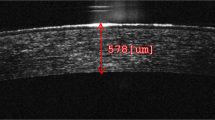Abstract
To compare the effect of Nd:YAG laser capsulotomy and primary posterior continuous capsulorhexis (PPCC) combined with phacoemulsification on macular thickness using optical coherence tomography (OCT) in adults. This prospective comparative interventional study included 32 eyes of 30 patients who underwent Nd:YAG laser capsulotomy and 33 eyes of 33 patients who underwent cataract surgery with PPCC. Detailed ocular examinations, including macular thickness measurements by OCT, were performed in all patients preoperatively and postoperatively on the 1st day, 1st week, and 1st, 3rd and 6th months. No significant differences were found in macular thickness between the two groups in preoperative and postoperative follow-up. No cystoid changes were observed in OCT during the postoperative period in both groups. Nd:YAG laser capsulotomy and PPCC combined with cataract surgery are safe and effective procedures that are not associated with an increase in macular thickness.
Similar content being viewed by others
References
Sundelin K, Shams H, Stenevi U (2005) Three-year follow-up of posterior capsule opacification with two different silicone intraocular lenses. Acta Ophthalmol Scand 83:11–19
Georgopoulos M, Menapace R, Findl O, Rainer G, Petternel V, Kiss B (2001) Posterior continuous curvilinear capsulorhexis with hydrogel and silicone intraocular lens implantation: development of capsulorhexis size and capsule opacification. J Cataract Refract Surg 27:825–832
Steinert RF, Puliafito CA, Kumar SR, Dudak SD, Patel S (1991) Cystoid macular edema, retinal detachment, and glaucoma after Nd:YAG laser posterior capsulotomy. Am J Ophthalmol 112:373–380
Burq MA, Taqui AM (2008) Frequency of retinal detachment and other complications after neodymium:Yag laser capsulotomy. J Pak Med Assoc 58:550–552
Galand A, van Cauwenberge F, Moosavi J (1996) Posterior capsulorhexis in adult eyes with intact and clear capsules. J Cataract Refract Surg 22:458–461
Van Cauwenberge F, Rakic JM, Galand A (1997) Complicated posterior capsulorhexis: aetiology, management, and outcome. Br J Ophthalmol 81:195–198
Nelson ML, Martidis A (2003) Managing cystoid macular edema after cataract surgery. Curr Opin Ophthalmol 14:39–43
Henderson BA, Kim JY, Ament CS, Ferrufino-Ponce ZK, Grabowska A, Cremers SL (2007) Clinical pseudophakic cystoid macular edema. Risk factors for development and duration after treatment. J Cataract Refract Surg 33:1550–1558
Ray S, D’Amico DJ (2002) Pseudophakic cystoid macular edema. Semin Ophthalmol 17:167–180
Yeh PC, Ramanathan S (2002) Latanoprost and clinically significant cystoid macular edema after uneventful phacoemulsification with intraocular lens implantation. J Cataract Refract Surg 28:1814–1818
Altintaş O, Yüksel N, Karabaş VL, Demirci G (2005) Cystoid macular edema associated with latanoprost after uncomplicated cataract surgery. Eur J Ophthalmol 15:158–161
Falcone PM (1996) Vitreomacular traction syndrome confused with pseudophakic cystoid macular edema. Ophthalmic Surg Lasers 27:392–394
De Groot V, Hubert M, Van Best JA, Engelen S, Van Aelst S, Tassignon MJ (2003) Lack of fluorophotometric evidence of aqueous–vitreous barrier disruption after posterior capsulorhexis. J Cataract Refract Surg 29:2330–2338
Smith RT, Moscoso WE, Trokel S, Auran J (1995) The barrier function in neodymium-YAG laser capsulotomy. Arch Ophthalmol 113:645–652
Ozaki L (1984) The barrier function of the posterior capsule. J Am Intraocul Implant Soc 10:182–184
Schalnus RW, Ohrloff C, Magone T (1995) The aqueous humor-vitreous body barrier and the blood–aqueous humor barrier after YAG laser capsulotomy in capsular sac vs ciliary sulcus fixation of the intraocular lens. Ophthalmologe 92:289–292
Lee MS, Lass JH (2004) Rapid response of cystoid macular edema related to Nd:YAG laser capsulotomy to 0.5% ketorolac. Ophthalmic Surg Lasers Imaging 35:162–164
Georgalas I, Petrou P, Kalantzis G, Papaconstantinou D, Koutsandrea C, Ladas I (2009) Nd:YAG capsulotomy for posterior capsule opacification after combined clear corneal phacoemulsification and vitrectomy. Ther Clin Risk Manag 5:133–137
Bukelman A, Abrahami S, Oliver M, Pollack A (1992) Cystoid macular oedema following neodymium:YAG laser capsulotomy a prospective study. Eye (Lond) 6:35–38
Albert DW, Wade EC, Parrish RK et al (1990) A prospective study of angiographic cystoid macular edema one year after Nd:YAG posterior capsulotomy. Ann Ophthalmol 22:139–143
Ursell PG, Spalton DJ, Whitcup SM, Nussenblatt RB (1999) Cystoid macular edema after phacoemulsification: relationship to blood–aqueous barrier damage and visual acuity. J Cataract Refract Surg 25:1492–1497
Stifter E, Menapace R, Neumayer T, Luksch A (2008) Macular morphology after cataract surgery with primary posterior capsulorhexis and posterior optic buttonholing. Am J Ophthalmol 146:15–22
Yazici AT, Bozkurt E, Altan C et al (2010) Macular thickness changes after phacoemulsification combined with primary posterior curvilinear capsulorhexis. Eur J Ophthalmol 20:376–380
Author information
Authors and Affiliations
Corresponding author
Rights and permissions
About this article
Cite this article
Kara, N., Yazici, A.T., Bozkurt, E. et al. Which procedure has more effect on macular thickness: primary posterior continuous capsulorhexis (PPCC) combined with phacoemulsification or Nd:YAG laser capsulotomy?. Int Ophthalmol 31, 303–307 (2011). https://doi.org/10.1007/s10792-011-9461-9
Received:
Accepted:
Published:
Issue Date:
DOI: https://doi.org/10.1007/s10792-011-9461-9




